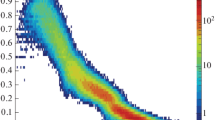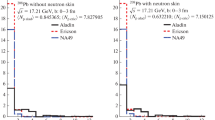Abstract
The Abrasion–Ablation Monte Carlo for Colliders (AAMCC) model is used to study the characteristics of spectator matter in central collisions of relativistic 238U nuclei, which are sensitive to the mutual orientation and the degree of deformation of the colliding nuclei. It is shown that the multiplicity of spectator neutrons and their forward-backward asymmetry substantially depend on the initial mutual orientation of 238U nuclei, which makes it possible to separate tip-body events with a high forward-backward asymmetry and a maximum multiplicity of spectator neutrons, as well as side-side events with a similar multiplicity, but with a minimal asymmetry. It is found that an increase in the quadrupole deformation parameter \({{\beta }_{2}}\) of 238U nuclei leads to a proportional increase in the multiplicity of spectator neutrons in tip-body events. Thus, the detection of spectator neutrons in collisions of relativistic deformed nuclei in an experiment can be used to study a degree of their deformation and to select collisions of a certain orientation.



Similar content being viewed by others
REFERENCES
E. Padilla-Rodal, “On the measurement of quadrupole moments of radioactive nuclei,” J. Phys. Conf. Ser. 322, 012004 (2011).
S. Raman, C. Nestor, and P. Tikkanen, “Transition probability from the ground to the first-excited 2+ state of even–even nuclides,” At. Data Nucl. Data Tables 78, 1–128 (2001). https://www.sciencedirect.com/science/article/pii/S0092640X01908587.
B. S. Ishkhanov and V. N. Orlin, “Employing a spheroidal global potential to estimate the quadrupole deformation of nuclei,” Phys. At. Nucl. 68, 1352–1371 (2005). http://link.springer.com/10.1134/1.2011495
J. A. Maruhn, P. G. Reinhard, P. D. Stevenson, J. R. Stone, and M. R. Strayer, “Dipole giant resonances in deformed heavy nuclei,” Phys. Rev. C 71, 064328 (2005). https://link.aps.org/doi/10.1103/PhysRevC.71.064328
V. Somà, “From the liquid drop model to lattice QCD,” Eur. Phys. J. Plus 133, 1–22 (2018).
V. Varlamov, V. Chesnokov, and S. Komarov, “Centre for photonuclear experiments data: Chart of nuclear shape and size parameters,” http://cdfe.sinp.msu.ru/ services/radchart/radmain.html.
P. Stránský, A. Frank, and R. Bijker, “On prolate shape predominance in nuclear deformation,” J. Phys.: Conf. Ser. 322, 012018 (2011). https://iopscience.iop.org/article/10.1088/1742-6596/322/1/012018.
P. Filip, “Elliptic flow in central collisions of deformed nuclei,” Phys. At. Nucl. 71, 1609–1618 (2008).
M. R. Haque, Z. W. Lin, and B. Mohanty, “Multiplicity, average transverse momentum, and azimuthal anisotropy in U + U Collisions at √s NN = 200 GeV using a multiphase transport model,” Phys. Rev. C 85, 034905 (2012). https://link.aps.org/doi/10.1103/PhysRevC.85.034905
L. Adamczyk et al. (STAR Collab.), “Azimuthal anisotropy in U + U and Au + Au collisions at RHIC,” Phys. Rev. Lett. 115, 222301 (2015). https://link.aps.org/doi/10.1103/PhysRevLett.115.222301
A. Goldschmidt, Z. Qiu, C. Shen, and U. Heinz, “Collision geometry and flow in uranium + uranium collisions,” Phys. Rev. C 92, 044903 (2015). https://link.aps.org/doi/10.1103/PhysRevC.92.044903
G. Giacalone, “Elliptic flow fluctuations in central collisions of spherical and deformed nuclei,” Phys. Rev. C 99, 1–10 (2019).
G. Giacalone, “Observing the deformation of nuclei with relativistic nuclear collisions,” Phys. Rev. Lett. 124, 202301 (2020). https://link.aps.org/doi/10.1103/PhysRevLett.124.202301
V. Bairathi, M. R. Haque, and B. Mohanty, “Selecting specific initial configurations using spectator neutrons in U + U collisions,” Phys. Rev. C 91, 054903 (2015). https://link.aps.org/doi/10.1103/PhysRevC.91.054903
S. Acharya, et al., “Anisotropic flow in Xe–Xe collisions at √s NN = 5.44 TeV,” Phys. Lett. B 784, 82–95 (2018). www.sciencedirect.com/science/article/pii/ S037026931830515X.
S. Chatterjee and P. Tribedy, “Separation of flow from the chiral magnetic effect in U + U collisions using spectator asymmetry,” Phys. Rev. C 92, 011902(R) (2015).
K. Fukushima, D. E. Kharzeev, and H. J. Warringa, “Chiral magnetic effect,” Phys. Rev. D 78, 074033 (2008). https://link.aps.org/doi/10.1103/PhysRevD.78.074033
A. O. Svetlichnyi and I. A. Pshenichnov, “Formation of free and bound spectator nucleons in hadronic interactions between relativistic nuclei,” Bull. Russ. Acad. Sci.: Phys. 84, 911–916 (2020). https://doi.org/10.3103/S1062873820080110
C. Loizides, J. Kamin, and D. D’Enterria, “Improved Monte Carlo Glauber predictions at present and future nuclear colliders,” Phys. Rev. C 97, 054910 (2018). https://doi.org/10.1103/PhysRevC.97.054910
Q. Shou, Y. Ma, P. Sorensen, A. Tang, F. Videbæk, and H. Wang, “Parameterization of deformed nuclei for Glauber modeling in relativistic heavy ion collisions,” Phys. Lett. B 749, 215–220 (2015). www.sciencedirect.com/science/article/pii/S0370269315005985.
T. Ericson, “The statistical model and nuclear level densities,” Adv. Phys. 9, 425–511 (1960). https://doi.org/10.1080/00018736000101239
A. S. Botvina, I. N. Mishustin, M. Begemann-Blaich, J. Hubele, G. Imme, I. Iori, P. Kreutz, G. J. Kunde, W. D. Kunze, V. Lindenstruth, U. Lynen, A. Moroni, W. F. Müller, C. A. Ogilvie, J. Pochodzalla, G. Raciti, T. Rubehn, H. Sann, A. Schüttauf, W. Seidel, W. Trautmann, and A. Wörner, “Multifragmentation of spectators in relativistic heavy ion reactions,” Nucl. Phys. A 584, 737–756 (1995). https://doi.org/10.1016/0375-9474(94)00621-S
R. C. Prim, “Shortest connection networks and some generalizations,” Bell Syst. Tech. J. 36, 1389–1401 (1957). https://doi.org/10.1002/j.1538-7305.1957.tb01515.x
J. N. De, S. K. Samaddar, X. Viñas, and M. Centelles, “Nuclear expansion with excitation,” Phys. Lett. B 638, 160–165 (2006). https://doi.org/10.1016/j.physletb.2006.05.046
V. E. Viola, K. Kwiatkowski, J. B. Natowitz, and S. J. Yennello, “Breakup densities of hot nuclei,” Phys. Rev. Lett. 93, 132701 (2004). https://doi.org/10.1103/PhysRevLett.93.132701
J. P. Bondorf, A. S. Botvina, A. S. Iljinov, I. N. Mishustin, and K. Sneppen, “Statistical multifragmentation of nuclei,” Phys. Rep. 257, 133–221 (1995). https://doi.org/10.1016/0370-1573(94)00097-M
V. F. Weisskopf and D. H. Ewing, “On the yield of nuclear reactions with heavy elements,” Phys. Rev. 57, 472–485 (1940). https://doi.org/10.1103/PhysRev.57.472
E. Fermi, “High energy nuclear events,” Prog. Theor. Phys. 5, 570–583 (1950). https://doi.org/10.1143/ptp/5.4.570
S. Agostinelli et al. (Geant4 Collab.), “Geant4—a simulation toolkit,” Nucl. Inst. Methods Phys. Res., Sect. A 506, 250–303 (2003). https://doi.org/10.1016/S0168-9002(03)01368-8
FUNDING
The study was supported by Russian Foundation for Basic Research, project no. 18-02-40035.
Author information
Authors and Affiliations
Corresponding author
Additional information
Translated by M. Samokhina
Rights and permissions
About this article
Cite this article
Kozyrev, N., Svetlichnyi, A., Nepeivoda, R. et al. Spectator Matter in Collisions of Relativistic Deformed Nuclei. Phys. Part. Nuclei 54, 605–612 (2023). https://doi.org/10.1134/S1063779623040214
Received:
Revised:
Accepted:
Published:
Issue Date:
DOI: https://doi.org/10.1134/S1063779623040214




